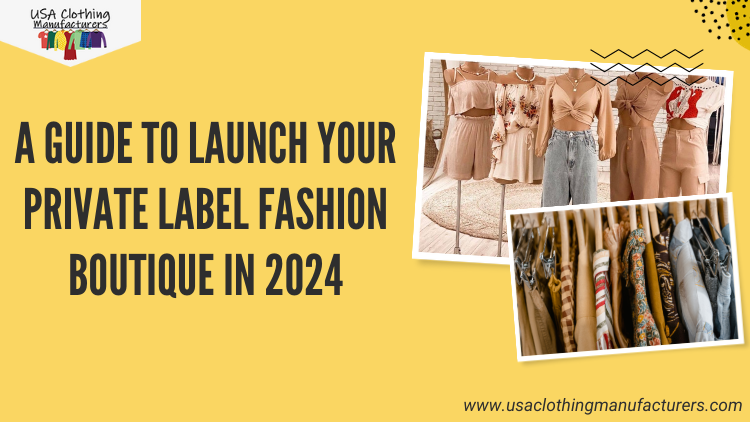

Private label fashion in 2024 isn’t just about creating another clothing line. It’s about carving out a unique identity in a saturated market. This requires an understanding of the nuances of the industry.
Entrepreneurs must stay in sync with global fashion trends while maintaining a keen eye on local consumer preferences. The idea is to merge global appeal with localized tastes.
Use demographic studies, fashion trend reports, and consumer behavior analysis to pinpoint where your brand can fill a gap in the market.
The initial phase involves research and understanding, setting the stage for a brand that resonates with a specific audience.
In-depth market research is crucial to find your place in the competitive fashion industry.
Start by analyzing existing brands, understanding their strengths, and identifying areas they overlook.
Are there underserved demographics? Is there a demand for more sustainable fashion practices that competitors are not fully addressing?
Gather data using tools like customer surveys, social media analytics, and trend forecasting reports. This information will help you shape a business model that caters to a specific market segment, whether that’s high-end luxury wear, affordable everyday fashion, or eco-conscious clothing.
Your niche should align with your interests and expertise. And also present a viable business opportunity.
Creating a strong brand identity involves more than picking a logo or color scheme. It involves defining the very essence of your brand.
What does your brand stand for? How does it speak to its audience?
Consider the emotional connection you want to establish with your customers.
Your branding should communicate this through every element, including product design, packaging, marketing materials, and social media presence.
A compelling brand story can be a powerful tool to connect with your audience. It should reflect in every aspect of your business, from the ethical sourcing of materials to customer service policies.
A comprehensive business plan is your blueprint for success. This should include detailed financial planning, with projections for startup costs, pricing strategies, and revenue models.
Marketing strategies should be outlined. It would highlight how you will reach your target audience, including digital marketing, traditional advertising, and public relations efforts.
Operational planning is equally important, detailing your supply chain, production process, and logistics.
This year, this also means being agile enough to adapt to changing market conditions and consumer behaviors. Your business plan should be a living document, evolving as your business grows and the market shifts.
The heart of a successful private label fashion boutique lies in its partnership with the right manufacturer. This choice is more crucial than ever.
A good manufacturer does more than just produce clothing. They bring your vision to life while maintaining quality and consistency.
Look for manufacturers with a strong track record in your niche market. They should be able to produce the quality and quantity you need, with scalability for future growth.
Prioritize manufacturers who are transparent about their production processes and are willing to collaborate closely with you.
When selecting a manufacturer, consider these key factors:
Building a strong, long-term relationship with your manufacturer benefits both parties.
Negotiate terms that are favorable but fair. This includes discussions on pricing, payment terms, minimum order quantities, and shipping arrangements.
A collaborative approach can lead to better understanding, flexibility, and loyalty, which is valuable for navigating the ups and downs of the fashion industry.
Ensure you and your manufacturer understand and comply with all relevant laws and regulations.
This includes labor laws, safety standards, and import/export regulations if you are sourcing from abroad.
It’s also essential to protect your designs and brand through appropriate intellectual property laws.
Launching your boutique, whether online, in a physical store, or both, requires rigorous planning and execution.
For an online presence, invest in a user-friendly, visually appealing website that reflects your brand’s aesthetic.
Ensure it’s optimized for mobile use and easy navigation. If opening a physical store, consider the location carefully. It should align with your target market’s demographics.
The store layout, design, and ambiance should resonate with your brand story. Hiring knowledgeable and customer-focused staff can significantly enhance the in-store experience.
In 2024, a dynamic and multi-layered marketing strategy is key.
Leverage digital marketing tools to reach a broader audience, including SEO, content marketing, and social media advertising.
Influencer collaborations can add credibility and widen your reach, especially if their followers align with your target demographic.
Also, don’t overlook the power of traditional marketing methods. Local events, pop-up shops, and collaborations with other local businesses can be very effective, especially for a physical store.
Your sales strategy should include transparent pricing, attractive promotions, and perhaps a loyalty program to encourage repeat business.
In an increasingly competitive market, customer experience is paramount. This includes everything from the browsing experience (both online and offline) to customer service, checkout, packaging, and after-sales support.
Personalized experiences, prompt responses to queries, and efficient handling of returns and exchanges can turn first-time buyers into loyal customers.
Once your boutique is up and running, the focus shifts to sustaining and growing your business. Continuously analyze market trends and customer feedback to adapt your product offerings.
Be open to expanding your product lines or exploring new markets as opportunities arise. Stay flexible and ready to pivot your strategies in response to changing market dynamics or consumer preferences.
Launching a private label fashion boutique in 2024 involves a blend of creativity, strategic planning, and adaptability.
From choosing the right manufacturer to setting up your boutique, crafting effective marketing strategies, and enhancing customer experience, each step is crucial for success.
With a clear vision and a well-executed plan, your private label fashion boutique can launch successfully and continue to grow and thrive in the dynamic world of fashion.